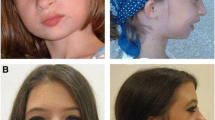Summary
A male newborn with the typical Langer type of mesomelic dwarfism is presented. The finding of a variable degree of Madelung's deformity and mesomelic shortening in both parents and in the maternal family tends to support the hypothesis that this type of mesomelic dwarfism may be the clinical manifestation of a homozygous state for dyschondrosteosis.
Similar content being viewed by others
References
Beighton, P.: Autosomal recessive inheritance in the mesomelic dwarfism of Campailla and Martinelli. Clin. Genet. 5, 363–367 (1974)
Blockey, N. J., Lawrie, J. H.: Unusual symmetrical distal limb deformity in siblings. J. Bone Joint Surg. 45, 745–747 (1963)
Böök, J. A.: A clinical and genetical study of disturbed skeletal growth (chondrohypoplasia). Hereditas 36, 161–180 (1950)
Brailsford, J. F.: Dystrophies of the skeleton. Br. J. Radiol. 8, 533–569 (1935)
Campailla, E., Martinelli, B.: Deficit staturale con micromesomelia. Minerva Ortop. 22, 180–184 (1971)
Espiritu, C., Chen, H., Woolley, P. V.: Mesomelic dwarfism as the homozygous expression of dyschondrosteosis. Am. J. Dis. Child. 129, 375–377 (1975)
Fryns, J. P., Mulier, F., Van Den Berghe, H.: A patient with Langer type of mesomelic dwarfism. Acta Paediatr. Belg. 29, 193–196 (1976)
Hall, J. G., Doest, J. P., Taybi, H., Scott, C. I., Langer, L. O., McKusick, V. A.: Two probable cases of homozygosity for the achondroplasia gene. Birth Defects: Original Article Series V, 4, 24–34 (1969)
Langer, L. O.: Dyschondrosteosis, a heritable bone dysplasia with characteristic roentgenographic features. Am. J. Roentgenol. 5, 178 (1965)
Langer, L. O.: Mesomelic dwarfism of the hypoplastic ulna, fibula, mandible type. Radiology 89, 654–660 (1967)
Leri, A., Weill, J.: Une affection congénitale et symétrique du développement osseux: la dyschondrostéose. Bull. Méd. Soc. Hop. Paris 53, 1491 (1929)
Nievergelt, K.: Positiver Vaterschaftsnachweis aufgrund erblicher Mißbildungen der Extremitäten. Arch. Julius Klaus-Stift. Vererbungsforsch., Sozialanthropol. Rassenhyg 19, 157–194 (1944)
Reinhardt, K., Pfeiffer, R. A.: Ulno-fibuläre Dysplasie. Eine autosomal-dominant vererbte Mikromesomelie ähnlich dem Nievergelt-Syndrom. Fortschr. Röntgenstr. 107, 379–391 (1967)
Silverman, F. N.: Mesomelic dwarfism. Prog. Pediat. Radiol. 4, 546 (1973)
Solonen, K. A., Sulamaa, M.: Nievergelt syndrome and its treatment. A case report. Ann. Chir. Gynaecol. Fenn. 47, 142–147 (1958)
Spranger, J. W., Langer, L. O., Wiedemann, H. R.: Bone dysplasias. An atlas of consitutional disorders of skeletal development. Stuttgart: Fischer 1974
Author information
Authors and Affiliations
Rights and permissions
About this article
Cite this article
Fryns, J.P., Van Den Berghe, H. Langer type of mesomelic dwarfism as the possible homozygous expression of dyschondrosteosis. Hum Genet 46, 21–27 (1979). https://doi.org/10.1007/BF00278898
Received:
Issue Date:
DOI: https://doi.org/10.1007/BF00278898




